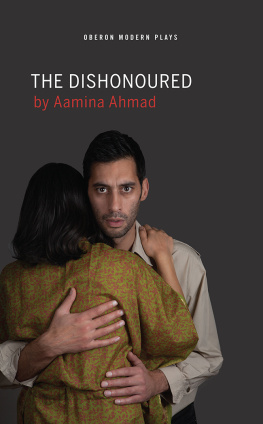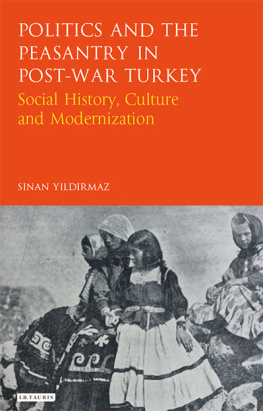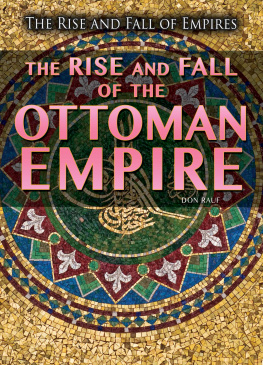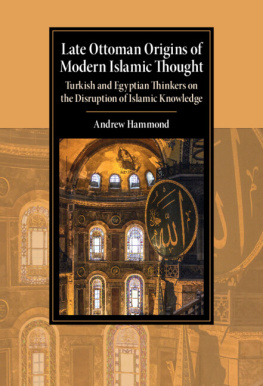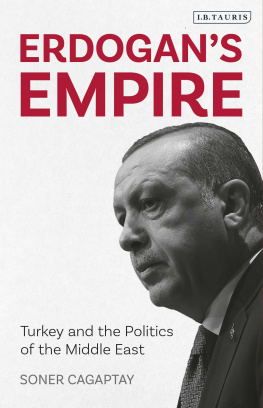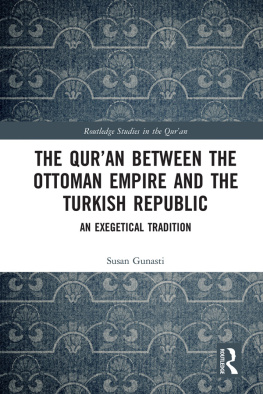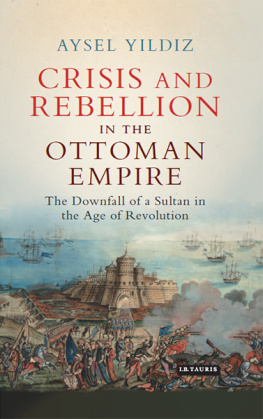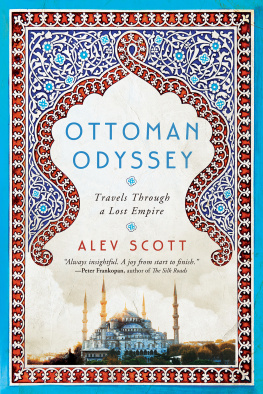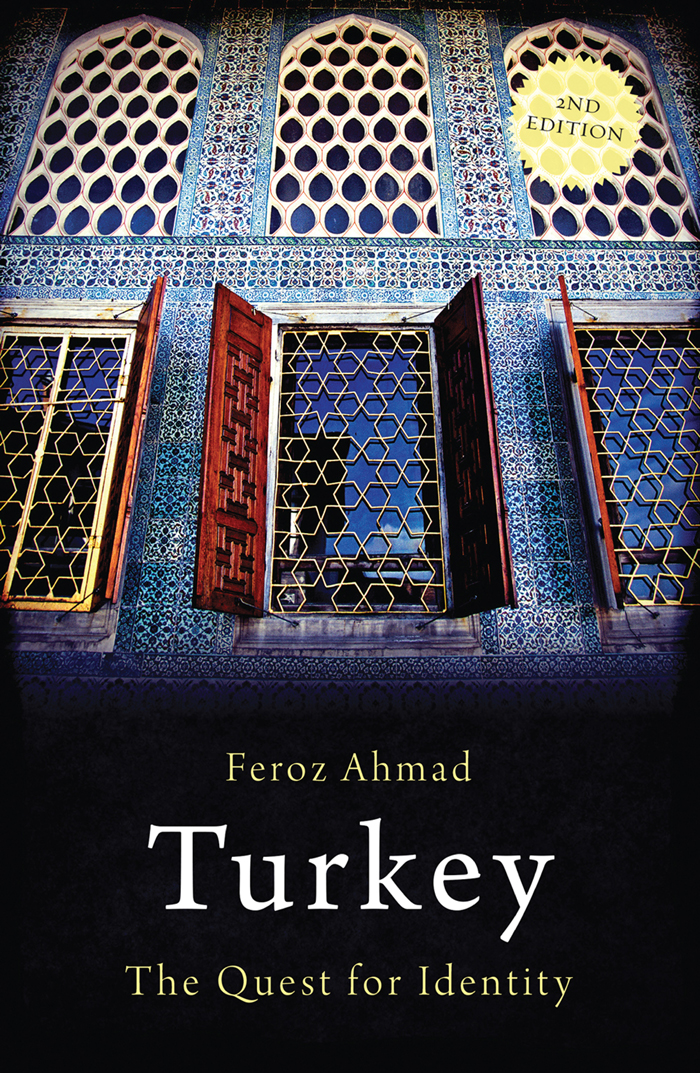ABOUT THE AUTHOR
Feroz Ahmad is Emeritus Professor of History at the University of Massachusetts and a Visiting Scholar at the Fares Center for Eastern Mediterranean Studies at Tufts University. He is widely respected as an expert on modern Turkey and Middle East history and, since 2005, has been teaching history and politics at Yeditepe University, Istanbul.
TURKEY
The Quest for Identity
Feroz Ahmad

A Oneworld Book
This ebook edition published by Oneworld Publications 2014
First published by Oneworld Publications 2003
This revised edition published in 2014
Copyright Feroz Ahmad 2003, 2014
The moral right of Feroz Ahmad to be identified as the Author of this
work has been asserted by him in accordance with the Copyright,
Designs, and Patents Act 1988
All rights reserved
Copyright under Berne Convention
A CIP record for this title is available from the British Library
ISBN 978-1-78074-301-1
eISBN 978-1-78074-302-8
Oneworld Publications
10 Bloomsbury Street
London WC1B 3SR
England
Stay up to date with the latest books,
special offers, and exclusive content from
Oneworld with our monthly newsletter
Sign up on our website
www.oneworld-publications.com
Contents
Preface
The Ottomans were a rare imperial people who had no homeland to retreat to as their empire waned in the nineteenth and twentieth centuries. Other imperial peoples had returned to various homelands: the British to their island base when they were forced to decolonize; the French to France, the Spanish to Spain, and so on. By the twentieth century, the Ottomans had no homeland for they had originated as tribal peoples who, for a variety of reasons, had been forced to migrate from the steppes of Central and Inner Asia and went in different directions. Some of these tribal confederations, including the ones who came to be known as Ottoman (Osmanl) adopting the name of their leader, Osman (d.1324), migrated into the Islamic world and adopted Islam.
These peoples came to be described as Turks by the people they intermingled with. But they themselves were called by the name of the head of their tribal confederation: thus the Seljuks, the Danimend, the Mentee and the Osmanli or Ottomans. The Ottomans reserved the name Turk for the nomadic tribesmen and peasants who continued to live under their rule but were as yet untamed or uncivilized. The merchants from the Italian city states of Venice and Genoa who came in contact with the Ottomans nevertheless called them Turks or Turque, as did the English and the French respectively. The Greek Orthodox described the rule of the Ottomans as Tuorkokratia, the rule of the Turks. For Europeans and Christians, the term Turk was synonymous with Muslim; thus when Christians converted to Islam, they were often said to have turned Turk. Turkey was also the English-language synonym for the Ottoman Empire; thus when Lord Byron wrote to his mother from Ottoman Albania in November 1809, he noted that I have been some time in Turkey: this place [Prevesa] is on the coast, but I have traversed the interior of the province of Albania on a visit to the Pasha. It was common for Europeans to speak of the Balkan provinces of the Ottoman Empire as Turkey-in-Europe and of Asia Minor and the Arab provinces as Turkey-in-Asia, when they described the geography of the empire.
The idea of nationalism made inroads into the Ottoman Empire after the French Revolution, first among the non-Muslim communities of the empire, and then among a minority of Muslim intellectuals who became conscious of their Turkishness, their language and their roots. But nationalism remained a concern of the minority, for the majority was still determined to maintain a multiethnic, multi-religious empire, right until the final defeat in 1918 during the First World War.
Only after total defeat and the realization that the victors were going to partition the empire and promote self-determination did the Ottomans realize that they too had to determine their identity on the basis of nationalism and nationhood.
When the nationalists created their republic in 1923, they were careful to call it the Republic of Turkey, a territorial and therefore a patriotic description, and not the Turkish Republic, which would have defined the republic ethnically. Nevertheless Trkiye Cumhuriyeti is often rendered incorrectly as the Turkish Republic and not the Republic of Turkey, and the assembly in Ankara as the Turkish Grand National Assembly and not the Grand National Assembly of Turkey. The nationalists were aware of the difference in meaning and chose their words with care. There was even a discussion about describing the people of the new Turkey as Trkiyeli, as the land of Turks, Kurds, Arabs, Circassians, etc., reserving the term Turk for the ethnically Turkish. Turk was retained but with the same kind of meaning as British or American. As with other national movements, having succeeded in creating the territorial state of Turkey and gaining it universal acceptance at Lausanne in 1923, the nationalists began the task of creating the nation of Turkey and the Turk.
By the late 1930s, the nationalists had partially succeeded in creating a new identity for most of the population of Anatolia, with only the Kurdish population in the east and the Alevis of central Anatolia remaining disaffected, the former on ethnic-linguistic grounds and the latter on religious grounds. These problems of identity remained dormant until the early 1960s when they began to emerge in the more liberal political environment created by the new constitution of 1961. They remained unresolved, though progress was made during the nineties when the state began considering the liberalization of the regime and the reforms that were required by the European Union in order to meet its criteria for membership. The new Justice and Development Party (AKP) claims to be more determined than ever to introduce and implement these reforms after its efforts to gain admission were foiled at the EU summit in Copenhagen on 1213 December 2002.
Acknowledgements
This book has grown out of a long-standing involvement with the history of the Ottoman Empire and modern Turkey. Since it is a work of synthesis, I stand on the shoulders of the scholars who have inspired me over the years, as well as students who forced me to reconsider the subject with questions I had not thought to ask. I should like to thank the two readers who read the work for Oneworld while it was in draft form and made helpful comments; my editors, Rebecca Clare and Judy Kearns, at Oneworld for their professionalism and patience; and my colleagues, especially Leila Fawaz, at the Fares Center for Eastern Mediterranean Studies at Tufts University, for their encouragement and support. However, I alone remain responsible for any errors of fact or omissions.
Notes on transcription
I have used the official modern Turkish when transcribing Turkish words and names in Roman script. Some indications on pronunciation are given to assist the reader not acquainted with Turkish.
c | j as in jam |
ch as in church |
soft g lengthens the preceding vowel and is not sounded, thus Erdoan is pronounced Erdoan |
(dotless i) something like u as in radium |



